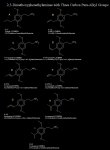>also shouldn't propynyl
>read propinyl, or is that
>language dependant?
According to my program which I used to make this sheet, it is propynyl. But now I am confused because of reading the MDPL entry in PIHKAL. He writes....
There is a continuing uncertainty about the name for the three-carbon radical that contains a triple bond. The hydrocarbon is propyne, although it has been referred to as methylacetylene in the older literature. The adjective, going from the triple bond out to the point of attachment, is called propargyl, as in propargyl chloride. When the adjective must be built on the parent hydrocarbon, the double bond is on the outside and one reads away from it, as in 2-propynyl something. However, when the hydrocarbon is essentially the entire structure, then things get named going towards the triple bond, as in 3-chloro-1-propyne. Wait. I'm not done yet! When the actual hydrocarbon name becomes distorted into the derivative, then the triple bond is again at the high end of the numbering scheme. Propynol is 2-propyn-1-ol, which is, of course, the same as 3-hydroxypropyne, or propargyl alcohol. The code MDPL takes the first and last letter of the two of them, both propargyl and propynyl.
Aside from the fact that E and F would be better called "2C-PL-x" (since he used PL as a shortening for propynyl), can propargyl be used for both the 1-propynyl and 2-propynyl groups, or does propargyl only refer to a 2-propynyl group?
And if the answer is yes; propargyl can be used for both 1-propynyl and 2-propynyl...is "4-(2-propargyl)" synonomous with "4-(2-propynyl)"? Or is the numbering reversed meaning 4-(2-propynyl is 4-(1-propargyl)?
I'm confused on whether I am to read towards the benzene ring, or away from it when numbering them.
Oh, one last thing for now...can G also be called 4-allenyl-2,5-DMPEA?
And if .
A part of me also wants to tie B, C, and D under one label since they are all contain a propenyl group. I say that assuming 2-propenyl is another name for allyl. Am I correct?
So anyone have access to QSAR to run some of these through? Or want to speculate on possible activity with their own on-board/in-brain QSAR? I just know in my heart B and F will be quite active, and I probably is too since DOIP is said to be active.
That such oddball things like 4-MEA, 3C-P, N-methyl-2C-H-beta-ketone, and other oddities made it to market, why didn't this one?!? The allyl group seems so appealing in AL-LAD, 5-MeO-DALT, and AL. I also bet the 4-allylthio analogue would be fantastic to taste.
Chemistry masturbation.





